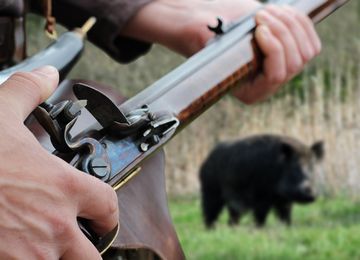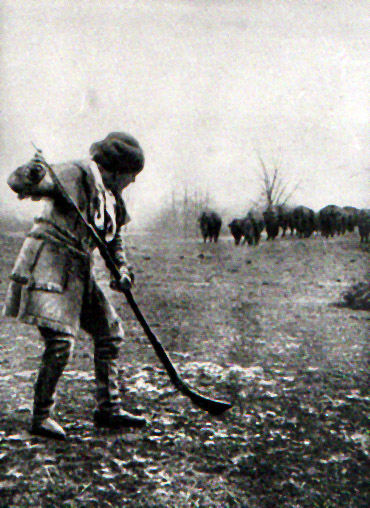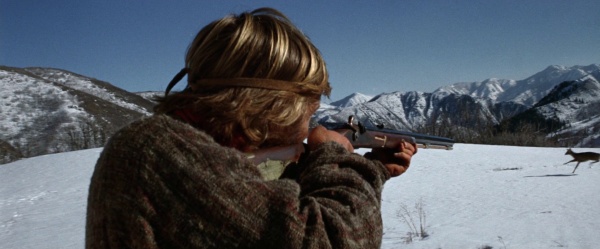
The reasons for choosing a traditional muzzle loader for hunting are almost as numerous as the people who do it. For some it’s simply a way to participate in a special muzzle loader season or enjoy additional days of hunting. For many it’s the nostalgia of doing things the way our ancestors did some 200 years ago. That special ambiance of being afield with the firearms of Daniel Boone, David Crocket and Jim Bridger. Some enjoy the meticulous attention to detail required for a successful hunt with a muzzle loader. Many will say it is because it offers an additional challenge and intrinsic appreciation for the hunt. If you enjoy being close to deer, or other game animals, if you have ever thought that sometimes it’s just a little too easy, you might be ready. Once you have experienced that brief but intense moment it takes for the smoke to clear, that nerve-wracking half-second when your vision is obscured and you wonder if your shot was as true as you thought, you'll understand the thrill and the challenge of hunting with a muzzle loader.
The most obvious challenge involved in muzzle loader hunting is the minute and a half it takes to re-load the gun. Shooting a muzzle loader is a slow and deliberate process. For all practical purposes the muzzle loading hunter limits himself to one shot at his intended quarry. This isn’t really much of a handicap as all hunters aspire to make one shot, clean kills out of respect for the game. Still, it is always there in the back of your mind that you need to be absolutely sure of your shot. You know that if you muff it, there won’t be an opportunity for a follow up shot. For that reason you will make every effort to get close to the game and set up the best possible circumstances for a clean, killing shot. If that doesn’t materialize you have the discipline and patience to pass up that animal and continue hunting for a better opportunity. This mindset simply makes us better hunters.
There is a learning curve to becoming a proficient muzzle loading hunter. If you expect reliable performance from the rifle you must do things in the proper sequence, and you have to think about what you're doing until it becomes habit. Misfires are very frustrating, the only way to prevent them is to become thoroughly familiar with your rifle and its idiosyncrasies. You have to learn how your rifle needs to be loaded, cleaned, and cared for. Do just one thing out of sequence, like putting the ball down the barrel before the powder, or skip a detail such as forgetting to pick the vent, and your rifle is not likely to fire when you pull the trigger. However, for those hunters who pay attention to the details and know what their gun will do under various conditions and circumstances, a muzzle loading firearm is very reliable.
Another challenge with muzzle loading rifles is the limit of attainable muzzle velocity. Because black powder can’t generate the pressures smokeless powder can under normal conditions, a muzzle loading rifle is doing well to reach velocities of 1,800 feet per second. Modern cartridge rifles commonly used for deer hunting will easily reach velocities of 2,900 feet per second and some will make 3,300 feet per second. In addition to lower muzzle velocities the lead round ball has a much lower ballistic coefficient than pointed bullets. A round ball is effected more by air resistance and the loss of velocity associated with it than a long streamlined bullet.
A bullet's kinetic energy, measured in foot-pounds is what's generally termed "stopping power." The higher a bullet's energy at the point of impact, the greater it’s "stopping power." Modern bullets for game hunting are designed to expand to a larger diameter than their caliber dimension. Expansion slows the bullet and sheds kinetic energy as it passes through the animal. This rapid expansion creates shock waves called hydrostatic shock which disrupts the nervous system and ruptures small blood vessels. Jacketed bullets also tend to break up releasing small fragments of jacket material which sever capillaries and blood vessels. Low velocity lead balls simply do not perform in the same manner. In practical terms, all this means that muzzle loaders have a more limited effective range than modern cartridge rifles.

Regardless of the modest ballistics of a muzzle loader, lead round balls usually provide extraordinary penetration. A ball of lead has a good deal of molecular cohesion, and though it may flatten on impact, a low velocity lead round ball will rarely break up. The key to performance on game with a muzzle loader is to use a large caliber round ball. The heavier the ball, the more effective it will be. A one hundred eighty three grain round ball fired from a .50 caliber rifle will usually go completely through a deer on a broadside shot, and a two hundred twenty four grain .54 caliber round ball always does.
For these reasons most States have minimum caliber restrictions for hunting big game with muzzle loaders. However, the acceptable calibers may not be consistent from one State to another. You will need to know the laws in your area before you decide what caliber to use. In States with no caliber restrictions, ethical hunters will always use enough gun to make sure, clean, one shot kills. Generally speaking, that means large caliber guns for big game and small calibers for small game.
Despite lackluster ballistics when compared to modern cartridge rifles, muzzle loading guns are much better at killing game than some may think. It may be inspiring to remember, there isn’t a mammal or bird in North America that hasn’t been killed by someone shooting a muzzle loader.
The use of traditional open sights is another challenge the muzzle loader hunter chooses. The ability to see your quarry and take accurate aim through open sights can be more of a distance limitation than the velocity or trajectory of the projectile. In other words, your rifle is capable of killing at longer distances than open sights will allow you to make an accurate shot. A good rule to follow is to get out and shoot until you know the distance at which you can keep all of your shots inside a standard eight inch paper plate. Consider that distance your effective deer hunting range under ideal conditions.
Wet or freezing weather can be a real challenge to the muzzle loading hunter. Finding ways to keep the powder dry and the rifle functioning under adverse conditions can be inspiring or discouraging. One way to deal with it is to simply stay indoors and wait for clear weather. But you won’t learn anything by doing that.
Water based patch lube and spit lube can freeze in cold weather or dry out during a day of hunting. These lubes may be great for target shooting but grease and oil based patch lubes serve best for hunting. Holding the rifle with the lock under your arm pit and the muzzle pointed down will help keep water from getting into the powder charge. Sealing the pan of a flintlock with grease will help also. Some shooters will prime the flintlock with 3-f or 2-f granulation powder during damp weather. The larger granules don’t seem to absorb moisture as quickly as finer 4-f powder. A leather cover called a “calf’s knee” is a traditional method to keep the lock dry during wet weather. Inserting the quill of a feather into the vent seals out moisture and is a very traditional method called “feathering the touch hole”. Covering the muzzle with a small finger cot or child’s toy balloon also helps keep the water out. One thing is certain, our forefathers learned to cope with foul weather conditions. With some research and a little experimentation in the field we can re-discover how they managed to do so.
Shooting a muzzle loader requires a certain minimum amount of necessary items and associated tools. You will also need something to contain those items to keep them organized and handy. Our great-grandfathers used shooting bags made of leather or coarse cloth for this purpose and a similar arrangement will serve as well today. The specific items necessary will vary according to the type and caliber of your gun and personal preferences. The following list of items is in no way meant to be all inclusive but may serve as a starting point. In addition to the items listed there are numerous gadgets that could make things easier. It is up to each hunter to decide which items are worthwhile.
- A flask or horn for your powder
- Powder measure
- A short bullet starter (used to start the bullet in the barrel)
- Capper
- Patches
- A patch knife (for cutting patches if you don’t use pre-cut ones)
- Patch lube
- A nipple pick (for cleaning out the nipple or touch hole)
- Cleaning jags
- Ball puller
- Spare flints
- Extra round balls
- Ball block (wooden block with holes that hold a pre-patched ball.)
- Speed loaders (paper or cane tubes that contain pre-measured powder charges)
If all this leaves you with the impression that muzzle loading rifles require more effort than modern breechloaders you would be correct. Hunting with a muzzle loader is very different than hunting with a modern scope sighted center fire rifle. You must be willing to accept the muzzle loading guns limitations and work within them rather than against them. You have to pay attention to the details. Hunting with a muzzle loader is more involved. It is also more rewarding. Try it once and chances are you are going to want to do it again.

